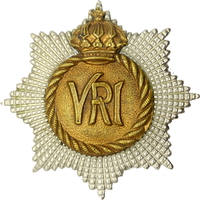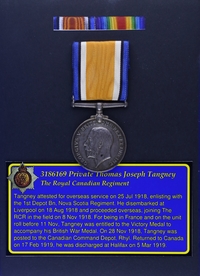
3186169 Private Thomas Joseph Tangney
The Royal Canadian Regiment
By: Capt (ret'd) Michael M. O'Leary, CD, The RCR
Born 23 Dec 1873 in Killarney, Ireland, Thomas Tangney was a 44-year-old machinist when he attested for over seas service in the Canadian Expeditionary Force. He enrolled at Camp Aldershot, Nova Scotia, on 25 Jul 1918 with "E" Company of the 1st Depot Battalion, Nova Scotia Regiment.
A married man, Tangney is described on his attestation paper as 5 feet 4 1/2 inches in height, with a 33 1/2-inch chest, dark complexion, brown eyes, and brown hair. His current address at time of enlistment, and the address of his wife, Margaret, as next of kin, was 88 Lawnsdale [Lonsdale] Ave., Pawtucket, Rhode Island, USA. Tangney's religious denomination was Roman Catholic.
Tangney sailed aboard the S.S. Ixion from Halifax, N.S., on 2 Aug 1918 and arrived at Liverpool, Eng., on 16 Aug 1918. He was immediately taken on the strength of the 17th Reserve Battalion at Bramshott and shown On Command, i.e., on temporary duty without changing parent units, to the Bourley Segregation Camp at Aldershot. Troops were placed in segregation camps to ensure that no communicable diseases would accompany them to France. In late 1918 the primary concern for this would have been the propagation of influenza through the C.E.F. After a month in the segregation camp, Tangney returned to Bramshott.
On 7 Nov 1918, Thomas Tangney was posted to The RCR. He crossed the Channel and landed in France on 8 Nov 1918 and was duly taken on the strength of the Regiment as a reinforcement.
Although he was officially on the unit's roll, there's little evidence to show that he actually made the journey from the Canadian Infantry Base Camp to join the Regiment in the field. On 16 Nov 1918, only eight days after being posted to The RCR, Tangney was classified "B.3," i.e., "men capable of sedentary work as clerks." As a result of this low category, he was transferred back to England and the Nova Scotia Regimental Depot (N.S.R.D.) at Bramshott on 26 Nov 1918.
The N.S.R.D. was part of the regionally based reinforcement system established in early 1918, with named Depots taking in troops from battalions raised in those areas in Canada and providing reinforcement drafts to similarly designated fighting units. The RCR, having been headquartered in Halifax in the decade before the War, was associated with the N.S.R.D. These Depots also became the parent unit for any soldiers returned to England from their affiliated battalions in France and Flanders.
Soon after arriving at the N.S.R.D., Tangney was posted to the Depot Company at Bramshott. On 19 Jan 1919 he was sent "On Command" to the Canadian Discharge Depot at Rhyl. From here, on 8 Feb 1919, Tangney was struck off the strength of the Overseas Military Forces of Canada (O.M.F.C.) for return to Canada.
Tangney returned to Canada aboard the S.S. Princess Juliana. He arrived in Halifax, N.S., on 17 Feb 1919 and was taken on the strength of District Depot No. 6 at Halifax. Medically examined before his release, it was noted that Tangney had a short forefinger on his right hand and that his eyesight was not as good as it had been on enlistment. He was discharged at Halifax on 5 Mar 1919 at the age of 45 years, 2 months.
For his service the Great War, Tangney received a War Service Gratuity of $216.20. This was paid out to him in five installments during March and April, 1919.
Having been posted to The RCR and being on the Regiment's roll and in France before 11 Nov 1918 was enough to ensure Tangney's entitlement to a pair of First World War medals. Thomas Tangney was awarded the British War Medal and the Victory Medal. These were sent to him at East Greenwich, Rhode Island, USA, on 17 Feb 1922.
Pro Patria
Visit a randomly selected page in The O'Leary Collection (or reload for another choice):
- The O'Leary Collection; Medals of The Royal Canadian Regiment.
- Researching Canadian Soldiers of the First World War
- Researching The Royal Canadian Regiment
- The RCR in the First World War
- Badges of The RCR
- The Senior Subaltern
- The Minute Book (blog)
- Rogue Papers
- Tactical Primers
- The Regimental Library
- Battle Honours
- Perpetuation of the CEF
- A Miscellany
- Quotes
- The Frontenac Times
- Site Map
QUICK LINKS
The O'Leary Collection—Medals of The Royal Canadian Regiment
Newest additions:
![]()
![]() SB-12725 Private Henry "Hank" Ard
SB-12725 Private Henry "Hank" Ard ![]()
WIA at Hill 187, Died of Wounds in Japan
![]()
![]() 2355331 Lance Corporal Albert Lorking
2355331 Lance Corporal Albert Lorking
Wounded in action, later a War Amps representative.
![]()
![]() 4334 / 477996 Pte Isaac Hamilton Wilcox
4334 / 477996 Pte Isaac Hamilton Wilcox
Permanent Force, South Africa, and C.E.F.
![]()
![]() 477019 Private Harold Ashcroft
477019 Private Harold Ashcroft
Transferred to the Tunnelers.
![]()
![]() 734231 Private Clark D. Thompson
734231 Private Clark D. Thompson ![]()
The older Thompson brother, killed in action.
![]()
![]() 733849 Private Norman Parker Thompson
733849 Private Norman Parker Thompson
The younger Thompson brother; post-war service in the Special Guard.
![]()
![]()
![]() A305 / 400305 Private Andrew Walker
A305 / 400305 Private Andrew Walker ![]()
"Previously reported Wounded, now Killed in Action."
![]()
![]() 823298 Pte Thomas Patrick Steele, M.M.
823298 Pte Thomas Patrick Steele, M.M. ![]()
… for gallant conduct in the field …
![]()
![]() P13066 Sergeant Harold Thompson
P13066 Sergeant Harold Thompson
Instrumental Soloist for over 20 years of Canadian Army service.
![]()
![]() 9609 / 477728 Private Albert Edward Piper
9609 / 477728 Private Albert Edward Piper
"Arrived from England as a STOWAWAY …"



